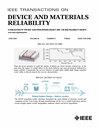Implication of Self-Heating Effect on Device Reliability Characterization of Multi-Finger n-MOSFETs on 22FDSOI
IF 2.5
3区 工程技术
Q2 ENGINEERING, ELECTRICAL & ELECTRONIC
IEEE Transactions on Device and Materials Reliability
Pub Date : 2022-06-16
DOI:10.1109/TDMR.2022.3183630
引用次数: 1
Abstract
In this paper, the self-heating effect for multi-finger fully depleted SOI nMOSFETs is investigated. The layout parameters of the transistor are varied, and the conductance-based method is used for the extraction of the thermal resistance. An empirical-based scalable thermal resistance model that accounts for geometrical layout parameters is developed. Further, hot carrier stress degradation is examined, and a correlation between self-heating and hot carrier degradation is established. The associated self-heating with geometrical dimension influences the amount of hot carrier degradation and should be taken into account for accurate degradation modeling. It is found that with the increase of temperature, the contribution of the parasitic bias temperature instability effect increases the drift of the threshold voltage. Improved thermal and reliability performance is achieved for the device structures where a continuous active area is divided into multiple smaller active regions.自热效应对22FDSOI多指n- mosfet器件可靠性特性的影响
本文研究了多指完全耗尽型SOI nmosfet的自热效应。晶体管的布局参数是不同的,热阻的提取采用基于电导的方法。建立了考虑几何布局参数的基于经验的可伸缩热阻模型。进一步,研究了热载子应力退化,并建立了自加热与热载子退化之间的相关性。与几何尺寸相关的自热影响热载体降解量,应考虑到准确的降解建模。研究发现,随着温度的升高,寄生偏置温度不稳定效应的贡献增大了阈值电压的漂移。将连续的有源区域划分为多个更小的有源区域,可以提高器件结构的散热性能和可靠性。
本文章由计算机程序翻译,如有差异,请以英文原文为准。
求助全文
约1分钟内获得全文
求助全文
来源期刊

IEEE Transactions on Device and Materials Reliability
工程技术-工程:电子与电气
CiteScore
4.80
自引率
5.00%
发文量
71
审稿时长
6-12 weeks
期刊介绍:
The scope of the publication includes, but is not limited to Reliability of: Devices, Materials, Processes, Interfaces, Integrated Microsystems (including MEMS & Sensors), Transistors, Technology (CMOS, BiCMOS, etc.), Integrated Circuits (IC, SSI, MSI, LSI, ULSI, ELSI, etc.), Thin Film Transistor Applications. The measurement and understanding of the reliability of such entities at each phase, from the concept stage through research and development and into manufacturing scale-up, provides the overall database on the reliability of the devices, materials, processes, package and other necessities for the successful introduction of a product to market. This reliability database is the foundation for a quality product, which meets customer expectation. A product so developed has high reliability. High quality will be achieved because product weaknesses will have been found (root cause analysis) and designed out of the final product. This process of ever increasing reliability and quality will result in a superior product. In the end, reliability and quality are not one thing; but in a sense everything, which can be or has to be done to guarantee that the product successfully performs in the field under customer conditions. Our goal is to capture these advances. An additional objective is to focus cross fertilized communication in the state of the art of reliability of electronic materials and devices and provide fundamental understanding of basic phenomena that affect reliability. In addition, the publication is a forum for interdisciplinary studies on reliability. An overall goal is to provide leading edge/state of the art information, which is critically relevant to the creation of reliable products.
 求助内容:
求助内容: 应助结果提醒方式:
应助结果提醒方式:


